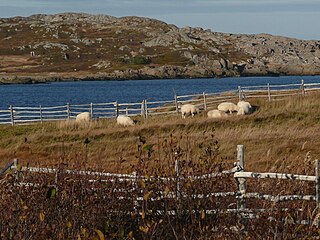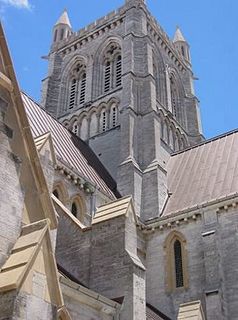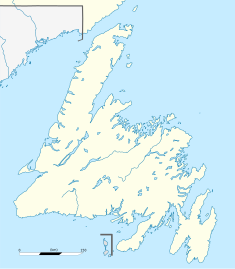
St. John's is the capital and largest city of the Canadian province of Newfoundland and Labrador, located on the eastern tip of the Avalon Peninsula on the island of Newfoundland.

Ferryland is a town in Newfoundland and Labrador on the Avalon Peninsula. According to the 2021 Statistics Canada census, its population is 371.

The Basilica-Cathedral of St. John the Baptist in St. John's, Newfoundland and Labrador is the metropolitan cathedral of the Roman Catholic Archdiocese of St. John's, Newfoundland and the mother church and symbol of Roman Catholicism in Newfoundland. The building sits within the St. John's Ecclesiastical District, a National Historic District of Canada.

The Cathedral of St. John the Baptist is located in the city of St. John's, Newfoundland and Labrador, Canada.
St. Bonaventure's College is an independent kindergarten to grade 12 Catholic School in St. John's, Newfoundland and Labrador, Canada. It is located in the St. John's Ecclesiastical District, adjacent to the Roman Catholic Basilica of St. John The Baptist. The school is named in honour of one of the Doctors of the Catholic Church, St. Bonaventure.

The Rooms is a cultural facility in St. John's, Newfoundland and Labrador, Canada. The facility opened in 2005 and houses the Art Gallery of Newfoundland and Labrador, the Provincial Archives of Newfoundland and Labrador and the Provincial Museum of Newfoundland and Labrador.

Harbour Grace is a town in Conception Bay on the Avalon Peninsula in the province of Newfoundland and Labrador, Canada. With roots dating back to the 16th century, it is one of the oldest towns in North America.

Quidi Vidi is a neighbourhood in St. John's, Newfoundland and Labrador. The village is adjacent to Quidi Vidi Lake. Quidi Vidi's harbour is known as "The Gut". Located in Quidi Vidi is the Quidi Vidi Battery Provincial Historic Site. The village is home to several small businesses.

Tilting is a community on the eastern end of Fogo Island off the northeast coast of Newfoundland. It was incorporated as a town before becoming part of the Town of Fogo Island through an amalgamation in 2011. The community has been designated as a National Historic Site of Canada, and has also been designated as a Registered Heritage District by the Heritage Foundation of Newfoundland and Labrador.

The Heritage Foundation of Newfoundland and Labrador (HFNL) or Heritage NL is a non-profit Crown corporation of the Government of Newfoundland and Labrador established in 1984 by the Historic Resources Act. Its mandate is to stimulate an understanding of, and an appreciation for, the architectural and intangible cultural heritage of Newfoundland and Labrador. In 2018 HFNL rebranded as Heritage NL for its public-facing work.

The Anglican Church of Bermuda is a single diocese consisting of nine parishes and is part of the Anglican Communion, though not a part of an ecclesiastical province. The current Bishop of Bermuda, seated at the Cathedral of the Most Holy Trinity in the City of Hamilton, is Nicholas Dill who was installed on 29 May 2013.
The architecture of St. John's, Newfoundland and Labrador has a style distinct from that of the rest of Canada, and its major buildings are remnants of its history and prestige as the first British colonial capital. The city of St. John's has had a long history, with inhabitation dating to the 16th century onwards. As the city grew, so, too, did the landscape. Buildings took a variety of styles according to the styles and means available to build the structures. Starting as a fishing outpost for European fishermen, St. John's consisted mostly of the homes of fishermen, sheds, storage shacks, and wharves. Of course, these structures were small and constructed out of wood. Like many other cities of the time, as the Industrial Revolution took hold and new methods and materials for construction were introduced, the landscape changed as the city grew in width and height. The Great Fire of 1892 destroyed most of the downtown core, and most residential and other wood-frame buildings date from this period. Often compared to San Francisco because of its hilly terrain and steep maze of residential streets, housing in St. John's is typically painted in bright colours, unlike most other parts of Canada.

The Anglican Diocese of Newfoundland was, from its creation in 1839 until 1879, the Diocese of Newfoundland and Bermuda, with the Cathedral of St. John the Baptist at St. John's, Newfoundland, and a chapel-of-ease named Trinity Church in the City of Hamilton in Pembroke Parish, Bermuda. Newfoundland and Bermuda had both been parts of British North America until left out of the 1867 Confederation of Canada. In 1879 the Church of England in the British Overseas Territory of Bermuda was created, but continued to be grouped with the Diocese of Newfoundland under the bishop of Newfoundland and Bermuda until 1919, when Newfoundland and Bermuda each received its own bishop.

The Cathedral of the Most Holy Trinity is an Anglican cathedral located on Church Street in the City of Hamilton, in Pembroke Parish, in the British Overseas Territory of Bermuda.

Bishop Feild College, founded in 1844, is a school in St. John's, Newfoundland. Founded as the Church of England Academy, it was renamed in 1892 as the Church of England College in 1892, before its 1894 name change to Bishop Feild College. The renaming was in honor of Bishop Edward Feild, a school inspector and second bishop of Newfoundland.
William Austin Oke was a newspaper publisher, politician, and District Court judge in Newfoundland. He represented Harbour Grace in the Newfoundland House of Assembly for three terms, from 1898 to 1908, as a Liberal.

The following outline is provided as an overview of and topical guide to Newfoundland and Labrador.
The Green Family Forge is a two-storey, wooden, heritage-designated blacksmith shop located at the intersection of West Street at Dandy Lane in Trinity, Trinity Bay, Newfoundland and Labrador.















